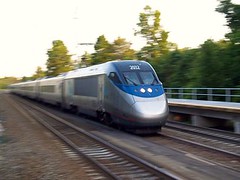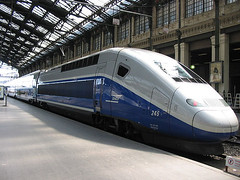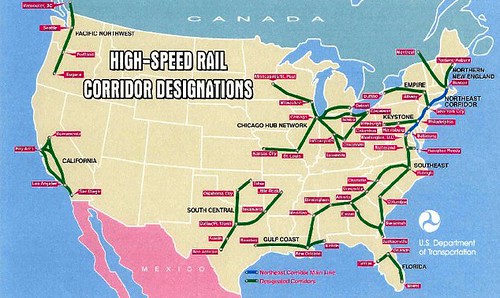Railway carriage charm: has high-speed rail’s moment arrived?

Posted March 9, 2009 at 1:29PM
Several days ago I made the trip from DC to New York and back via Amtrak's Acela Express, my mode of choice for the last decade or so. It's less expensive than the air shuttles, much more comfortable, much less stressful, and almost as time-efficient. Heck, it's more time-efficient if I'm working en route, since it's much easier to work on the train than on the plane or in the airport waiting lounge. Like the air shuttles, the express train leaves hourly (and there are also slightly slower trains leaving in between the Acela's departures.)
I head straight for the train's "Quiet Car" to avoid the distraction of compulsive bozos yammering away on their cell phones, settle in with work or good reading material, and I'm in the heart of Manhattan in a little over two and a half hours. The refreshments on board are good, too.
 Last weekend, it could not have been more convenient: I walked off the train, out of New York's Penn Station, across the street from Penn Station to my hotel, and then back across the street later for a concert at the WaMu Theatre in Madison Square Garden.
Last weekend, it could not have been more convenient: I walked off the train, out of New York's Penn Station, across the street from Penn Station to my hotel, and then back across the street later for a concert at the WaMu Theatre in Madison Square Garden.
It's the way to go. But that sort of comfort, efficiency and convenience via rail travel has largely been available only on the East Coast, in the Washington-to-Boston Corridor. With very few exceptions, city-to-city travel in the US by rail is, if available at all, generally slow and inconvenient outside of the Northeast. Visitors from other countries are shocked, given the large number of trips that are within a 100-400-mile distance but for which travelers are generally forced to go by air or personal car.
But president Obama is out to change that, and bring high-speed rail to more Americans. Writing in Sunday's Washington Post, Dan Eggen reports:
"The Northern Lights Express is little more than an idea -- a proposal for a 110-mph passenger train between Minneapolis and Duluth, Minn., that has crept along in fits and starts for years.
"But the slow ride may soon be over. The project is one of dozens nationwide that are likely to benefit from President Obama's initiative to fund high-speed and intercity passenger rail programs, including $8 billion in stimulus money and $5 billion more over the next five years in the administration's proposed transportation budget.
"The money represents the first major step toward establishing a genuine high-speed train network in the United States and has sparked a stampede among states, advocacy groups and lobbyists who are not accustomed to this level of funding . . ."
Possible routes include San Diego-Los Angeles-San Francisco-Sacramento; Brimingham-Atlanta-Charlotte-Raleigh-DC; Chicago-Milwaukee-Minneapolis-Duluth; and quite a few others (see map above for potential routes identified by the US Department of Transportation in 2005).
This is not a new idea for the president, who stressed it during his campaign. In his remarks to the US Conference of Mayors (recounted here last year), Obama noted that engineers in China were developing a 300-mph train. "I don't want to see the fastest train in the world built halfway around the world in Shanghai," Obama said. "I want to see it built right here in the United States of America."
 As many readers may know, convenient intercity rail is one of the great pleasures of traveling in Europe. If you're lucky, maybe you've ridden France's TGV, which I believe still holds a record for the world's fastest train, or even Japan's famous "Bullet Train," the Shinkansen. Now, high-speed rail in the US may not match the very fastest service in Europe or Asia, given our aging rail infrastructure. But bringing Acela-comparable service to more US cities would not only be much more efficient environmentally than flying or driving, it would also reduce stress for travelers.
As many readers may know, convenient intercity rail is one of the great pleasures of traveling in Europe. If you're lucky, maybe you've ridden France's TGV, which I believe still holds a record for the world's fastest train, or even Japan's famous "Bullet Train," the Shinkansen. Now, high-speed rail in the US may not match the very fastest service in Europe or Asia, given our aging rail infrastructure. But bringing Acela-comparable service to more US cities would not only be much more efficient environmentally than flying or driving, it would also reduce stress for travelers.
A couple of weeks ago, after the Senate passed the stimulus legislation, Senate Republican leader Mitch McConnell derided the new law as "a dramatic move in the direction of indeed turning America into Western Europe." Hmmmm. As Hendrik Hertzberg dryly alluded in the New Yorker, "greater income equality, better health, and fewer prisons" might not be so bad. If you ask me, neither would high-speed, intercity rail - or better mass transit, more walkable cities, and about half the carbon emissions per capita of the US, not to mention the wine and shorter work week. Sign me up.
The inspiration for today's title came from these lyrics.
